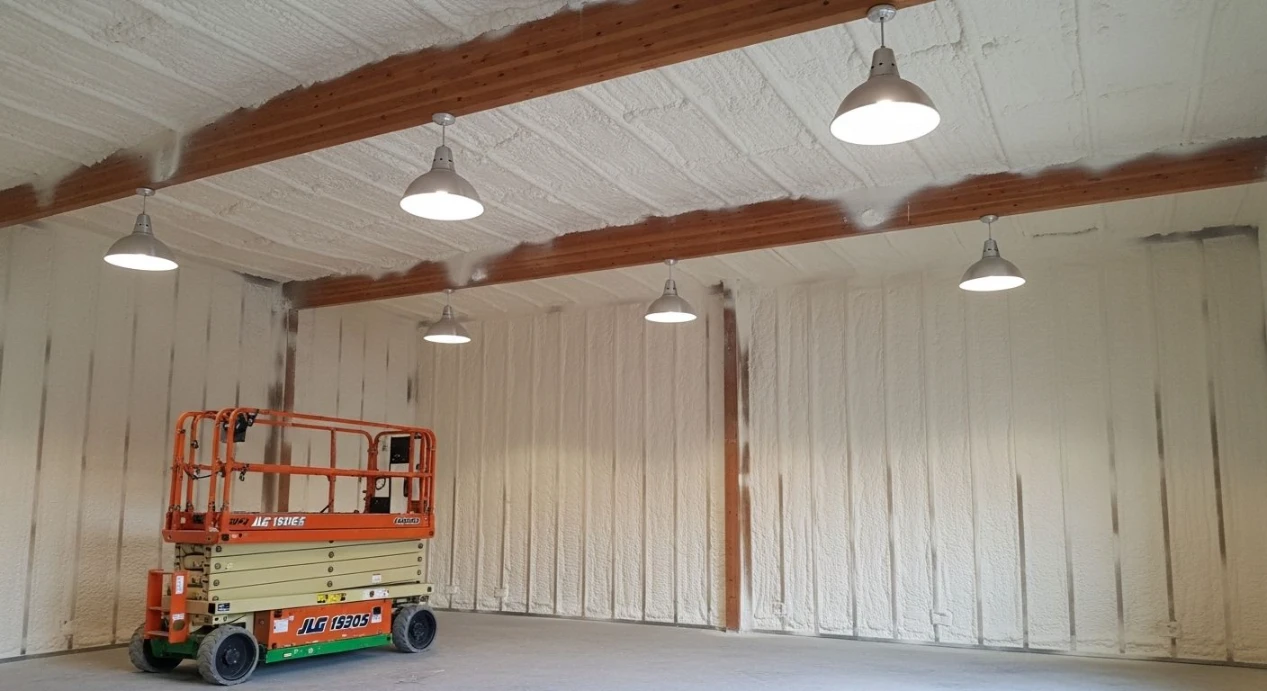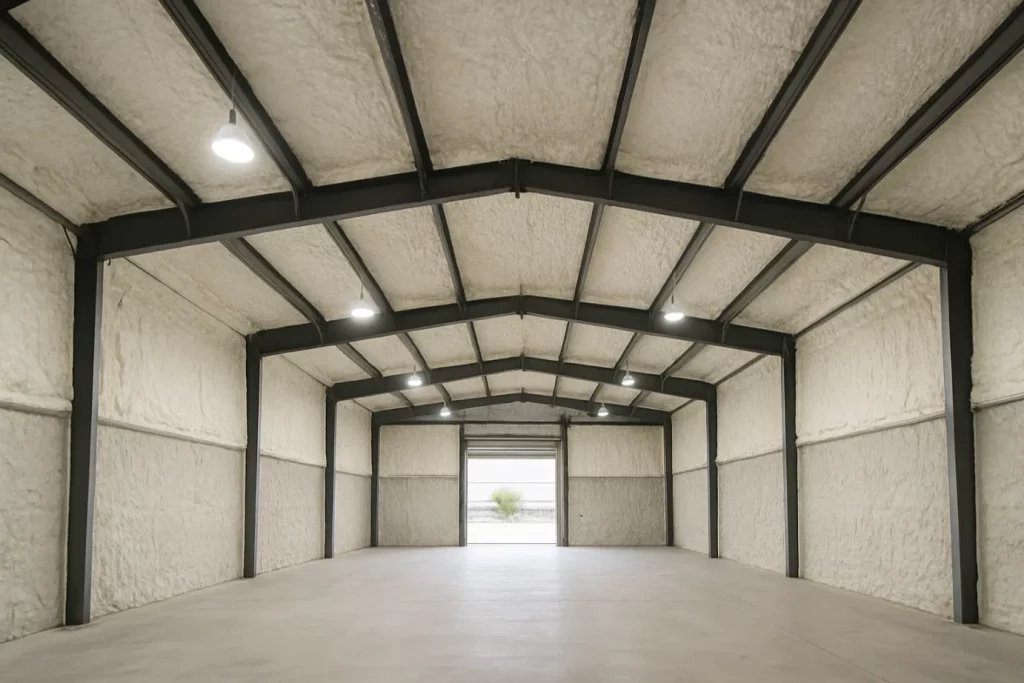
Proper surface preparation is the single most important factor for a successful spray foam insulation application. The foam’s ability to create a lasting, effective air and thermal barrier depends entirely on its bond with the surface, or substrate. If the surface is dirty, damp, or otherwise compromised, the foam will not adhere correctly. This can lead to delamination, air gaps, and a significant loss of insulation value, ultimately undermining the entire investment. As the spray polyurethane foam insulation market continues to grow, understanding these risks is more critical than ever for homeowners.
This guide explains the necessary steps for preparing surfaces, the consequences of skipping them, and the technical reasons behind these requirements. The information is based on extensive field experience to ensure you understand what a professional application entails.
Spray Polyurethane Foam (SPF) is created through a chemical reaction that makes it expand and harden. During this process, it bonds directly to the material it’s sprayed onto. This bond is what creates the seamless air barrier that makes spray foam so effective. For that bond to form correctly, the surface must be clean, dry, and structurally sound.
Any contaminant, from a fine layer of dust to a small patch of moisture, can interfere with this chemical bond. Think of it like trying to apply a piece of tape to a dusty or wet wall; it simply won’t stick properly. The same principle applies to spray foam, but the consequences are much more serious than a piece of peeling tape.
Achieving an ideal surface involves several distinct steps. The specific actions depend on the substrate material, but the core principles remain the same: the surface must be clean, dry, and free of any loose material.
All surfaces must be completely free of contaminants that could prevent adhesion. This includes:
Moisture is a primary cause of spray foam application failure. The water on a damp surface can interfere with the foam’s chemical reaction, leading to poor cell structure, bad adhesion, and even shrinkage. A professional installer will use a moisture meter to check the substrate, especially wood and concrete. According to the Spray Polyurethane Foam Alliance (SPFA), wood moisture content should generally be below 19% before applying spray foam.
Bonus Tip: In humid climates like Kentucky, it’s not just about visible water. Substrates can hold ambient moisture. Professionals will often use large fans or dehumidifiers for a day or two before application, especially in basements and crawl spaces, to ensure the surface is truly dry.
Both the surface temperature and the ambient air temperature affect how the foam cures. Most foam products have a specific temperature window for application, often between 60°F and 80°F. If the surface is too cold, the foam may not cure properly and could pull away. If it’s too hot, the reaction can happen too quickly, affecting the foam’s density and structure.
Cutting corners on surface prep leads to predictable and costly problems.

Different materials require slightly different approaches. The following table outlines the general preparation steps for common substrates.
| Substrate Material | Key Preparation Steps | Common Challenges |
|---|---|---|
| Wood (Plywood, OSB) | Vacuum or blow off all sawdust and debris. Check moisture content. | Hidden moisture, especially in new lumber. Some engineered woods have coatings that can resist adhesion. |
| Metal (Steel Studs, Q-Deck) | Remove any rust with a wire brush. Clean off oils with a degreaser. | Smooth surfaces can sometimes require a primer for maximum adhesion. |
| Concrete/Masonry | Remove any loose or crumbling material. Ensure the surface is fully cured (at least 28 days for new concrete) and dry. | Porosity and residual moisture from the curing process. |
| Drywall (Gypsum Board) | Wipe down the surface to remove all dust from the manufacturing and installation process. | The paper facing can be damaged by aggressive cleaning methods. |
Before any foam is sprayed, a thorough assessment of the project area is necessary.
Older homes often present unique challenges. Surfaces may be covered in multiple layers of old paint or have plaster that is not well-secured to the lath. These surfaces must be evaluated to ensure they are stable enough to hold the foam.
Consider the history of the space. A garage floor may have years of oil spills that have soaked into the concrete. A basement wall might have efflorescence (salt deposits from moisture) that indicates an ongoing water issue that needs to be solved before insulation is applied.
In areas with high humidity, scheduling is important. Applying spray foam on a damp, rainy day is not ideal. It’s best to wait for a period of dry weather to allow the structure to air out and the substrate to dry completely. A professional will also monitor the dew point to prevent condensation from forming on the surface during application.
Bonus Tip: In regions with cold winters, it’s also important to ensure the substrate isn’t frozen. Applying foam to a frosty surface is a guarantee for adhesion failure.
Yes. Even new lumber and sheathing are covered in sawdust and can have high moisture content from being stored outside. Every surface must be properly cleaned and tested for moisture before application.
No. Spray foam needs to bond to a solid substrate like wood sheathing or drywall. It cannot be applied over existing fiberglass batts or loose-fill insulation. All old insulation must be completely removed first.
Understanding the specific needs of your project is the first step. For a detailed evaluation of your home or building, you can contact Armored Insulation for a consultation. A team member can answer your questions and provide a clear plan for your insulation needs. Reach out to the team at (270) 331-4844 or send an email to [email protected] to discuss your project.
The surface should be clean enough that you could run your hand over it without picking up any dust, dirt, or grime. It doesn’t need to be sterile, but it must be free of any loose particles or chemical residues.
The foam will likely have a poor cure, appear spongy or crunchy, and will peel away from the surface easily. The moisture turns to steam during the exothermic reaction, creating pockets and preventing a solid bond.
Not always, but it is often recommended, especially for smooth or galvanized steel. A primer etches the surface and creates a superior profile for the foam to adhere to, ensuring a long-term bond. An experienced installer will assess the specific type of metal and conditions to make that call.
While you can do basic cleaning like sweeping or vacuuming, it’s best to let the professionals handle the final preparation. They have the right equipment, like high-powered vacuums and moisture meters, and the expertise to identify subtle problems you might miss. Improper prep can void warranties and lead to costly failures.
This depends entirely on the material and the ambient conditions. After a rainstorm, wood sheathing might need 24 to 48 hours of dry, breezy weather to reach an acceptable moisture level. Fresh concrete needs to cure for at least 28 days. There’s no single answer, which is why professional moisture testing is so important.
Surface preparation is not an optional step or a place to cut corners. It is the groundwork that determines the performance, efficiency, and lifespan of your spray foam insulation. A properly prepared surface ensures the foam creates a powerful, continuous bond, delivering the full thermal and air-sealing benefits you expect. Always ensure that a thorough cleaning, drying, and inspection process is part of any spray foam insulation proposal.